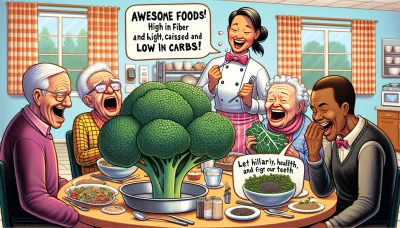Wise and healthy aging Quiz
Test Your Knowledge
Question of
Understanding Wise and Healthy Aging
Defining Healthy Aging
Healthy aging is about maximizing your potential for physical, social, and mental well-being throughout your life. It's not merely the absence of disease, but the maintenance of functional ability and quality of life as you grow older. This concept is rapidly gaining traction as populations around the world age.
The aim is to extend the years of healthy life by preventing or delaying the onset of chronic diseases. Emphasis on regular exercise, balanced nutrition, and mental health checks are pivotal. By focusing on these areas, individuals can greatly influence their aging process.
The Biological Perspective
From a biological standpoint, healthy aging involves the slowing down of cellular deterioration. This natural process can be influenced by genetics but is also heavily impacted by lifestyle choices. Engaging in activities that stimulate both body and mind plays a critical role in sustaining good health.
Regular health screenings are essential for early detection of age-related conditions. Advances in medicine and technology offer numerous ways to manage and even reverse some aspects of aging, emphasizing prevention over treatment.
The Psychological Perspective
Psychologically, healthy aging encompasses resilience and the ability to cope with life's changes. Maintaining strong social connections and having a sense of purpose has been linked to improved mental health among older adults. It's about adapting to new roles and finding fulfillment in activities beyond ones career.
Mental stimulation through learning new skills or hobbies can protect cognitive function. Encouraging lifelong education contributes significantly to psychological well-being in later years.
Key Components of Wisdom in Aging
Wisdom in aging refers to the insightful perspectives and decision-making abilities that come with experience. It's an amalgamation of knowledge, deep understanding, and empathy gained over time. The wise application of this knowledge is what sets apart simply growing old from aging well.
Wisdom isn't solely about intelligence; it's also about applying life lessons in a meaningful way. This includes understanding oneself, others, and the complex interplay between different life events.
Emotional Regulation
One key aspect of wisdom is emotional regulationthe ability to manage one's emotions effectively. Older individuals often exhibit a heightened capacity for controlling their emotions, leading to better conflict resolution and stress management. This skill contributes significantly to interpersonal relationships and overall happiness.
- Acknowledge your emotions: Recognize what you're feeling without judgment.
- Practice mindfulness: Stay present in the moment to better understand your emotional responses.
- Develop coping strategies: Identify healthy ways to deal with stress and emotional upheaval.
- Maintain social support: Share your experiences with friends or family members who can provide perspective.
- Seek professional help if needed: Don't hesitate to consult a therapist for guidance on managing complex emotions.
Experience-Based Knowledge
Experience-based knowledge is another cornerstone of wisdom in aging. This form of knowledge arises from lived experiences rather than theoretical understanding alone. It enables older adults to navigate life's challenges with greater ease and provide valuable insights to younger generations.
Leveraging this knowledge requires reflection on past events and an openness to learn from both successes and failures. Sharing these lessons can foster intergenerational connections and contribute to societal growth.
The Role of Diet in Aging Gracefully
Nutritional Needs for Seniors
As we age, our bodies undergo a myriad of changes that can affect our nutritional requirements. Seniors need a balanced diet rich in nutrients to maintain health, muscle mass, and bone density. It's crucial to focus on nutrient-dense foods that provide high levels of vitamins and minerals while being mindful of calorie intake.
Protein becomes increasingly important for maintaining muscle mass and repairing tissues. Foods such as lean meats, beans, and legumes are excellent sources. Additionally, fiber is essential for digestive health, which can be supported by incorporating whole grains, fruits, and vegetables into daily meals.
Essential Vitamins and Minerals
Vitamins D and B12 are particularly essential for seniors, with Vitamin D supporting bone health and B12 aiding in nerve function and the production of DNA. A lack of these can lead to serious health issues. Sources include fortified foods, dairy products, and supplements upon a doctor's advice.
Calcium is another key player in the aging process, vital for maintaining strong bones and preventing osteoporosis. Dairy products, green leafy vegetables, and calcium-fortified foods should be staples in a senior's diet to meet the recommended dietary allowances.
Hydration and Its Importance
Hydration is often overlooked but it is paramount for aging adults. Dehydration can lead to confusion, urinary tract infections, and even hospitalization. Seniors should aim to drink at least eight glasses of water per day unless otherwise directed by a healthcare professional.
While water is the best source for hydration, other fluids like herbal teas or water-rich fruits can also contribute positively. Limiting diuretics like caffeine and alcohol can help maintain hydration levels throughout the day.
Common Dietary Concerns for Older Adults
With age comes an increased risk for chronic conditions such as diabetes, heart disease, and hypertension which can all be influenced by diet. A heart-healthy diet low in sodium and saturated fats can help manage these conditions effectively.
Paying attention to food labels is crucial as hidden sugars and sodium can sneak into the diet through processed foods. Opting for whole foods over processed options helps control intake of these potentially harmful ingredients.
Managing Chronic Conditions
- *Focus on heart-healthy fats found in nuts, seeds, avocados, and olive oil. *Incorporate plenty of fruits and vegetables to increase antioxidant intake. *Choose high-fiber foods like whole grains to aid in blood sugar regulation. *Limit intake of refined sugars and flours which can exacerbate certain conditions. *Monitor portion sizes to prevent weight gain which can put extra stress on the body. *Stay active alongside a healthy diet to optimize management of chronic conditions.
Preventing Nutrient Deficiencies
Nutrient deficiencies can be common in seniors due to factors like reduced food intake or limited variety in their diets. Regular screenings for deficiencies are important as they may not always present with clear symptoms.
To prevent deficiencies, seniors should consume a variety of foods from all food groups. Supplementation may be necessary but should always be done under medical supervision to ensure safety and proper dosage.
Anti-Aging Foods to Incorporate into Your Diet
Superfoods for Longevity
The quest for longevity has never been more attainable with the inclusion of superfoods in your diet. These nutrient powerhouses help ward off chronic diseases and keep your body in prime condition. Including a variety of these foods is key to unlocking a healthier, longer life.
Superfoods are not just a fad; they are backed by science to improve overall health. They are rich in vitamins, minerals, and antioxidants that combat the effects of aging. By incorporating superfoods into your meals, you're investing in your future self.
Berries and Their Antioxidants
Berries are nature's sweet gift that packs a punch when it comes to anti-aging benefits. They're loaded with antioxidants like vitamin C and flavonoids which help fight off oxidative stress, a leading cause of aging. Eating berries regularly can be a delicious way to boost longevity.
Each variety of berry brings its own set of powerful nutrients. Blueberries are renowned for their brain health benefits, while raspberries contain ellagic acid, which helps skin stay youthful. Don't hesitate to mix them up for a colorful and healthy addition to your diet!
Leafy Greens and Cognitive Health
Leafy greens are not just for salads; they're brain food! Studies link the consumption of greens like spinach and kale to slower cognitive decline thanks to their high levels of vitamins K, lutein, and folate. Make leafy greens a staple in your diet for a sharp mind.
Incorporating leafy greens into your diet can be simple and tasty. Whether it's a smoothie, sauted side dish, or raw salad, these vegetables support brain health with every bite. Remember, the darker the green, the more nutrient-dense it is!
Balancing Macronutrients for Energy and Health
A balanced intake of macronutrients is essential for maintaining energy levels and supporting overall health as we age. Carbohydrates, proteins, and fats each play unique roles in our bodily functions. The key is finding the right balance that fuels your body optimally.
Maintaining this balance isn't just about quantity; it's about quality too. Choosing complex carbs over simple sugars, lean proteins over fatty cuts of meat, and healthy fats over saturated fats can make all the difference in how you feel and age.
Proteins and Muscle Maintenance
Proteins are vital for muscle maintenance, especially as we age and start losing muscle mass naturally. High-quality protein sources like eggs, fish, legumes, and lean meats help repair tissues and support muscle strength.
- Eat varied protein sources throughout the week to ensure you're getting all essential amino acids.
- Aim for at least one serving of protein with every meal to support muscle health.
- Consider plant-based proteins such as lentils or quinoa for added fiber benefits.
- Incorporate protein-rich snacks like Greek yogurt or nuts to keep energy levels steady between meals.
Healthy Fats and Brain Function
Fats have been demonized in the past but understanding the difference between healthy fats and unhealthy ones is crucial for brain health. Omega-3 fatty acids found in fish oil, flaxseeds, and walnuts are known to enhance cognitive function and may prevent age-related mental decline.
Including healthy fats in your diet isn't just good for your brain; it also helps absorb fat-soluble vitamins A, D, E, and K which are essential for many body functions. So go aheadadd some avocado to your sandwich or dress your salad with olive oil for a brain-boosting meal!
Dietary Patterns for Optimal Health in Later Years
The Mediterranean Diet and Its Benefits
Embrace the vibrant flavors of the Mediterranean diet to unlock a treasure trove of health benefits! This diet is rich in fruits, vegetables, whole grains, and healthy fats, particularly olive oil. It has been associated with a reduced risk of heart disease, diabetes, and certain cancers. Not only does it support physical health, but it also contributes to cognitive well-being.
The Mediterranean diet is not just about individual ingredients; it's a holistic approach to eating that emphasizes variety and moderation. It encourages consuming fish and poultry over red meat and choosing natural herbs and spices instead of salt. This dietary pattern is as delicious as it is nutritious, making it a sustainable choice for long-term health.
Heart Health and Olive Oil
The heart-healthy reputation of the Mediterranean diet owes much to olive oil, a staple fat source brimming with monounsaturated fats. These fats are champions at improving cholesterol levels and stabilizing blood sugar. Olive oil also contains polyphenols, which are compounds that fight inflammation and may protect blood vessels.
To maximize benefits, opt for extra-virgin olive oil it's least processed and retains the highest levels of antioxidants. Incorporating olive oil into your diet can be as simple as drizzling it over salads or using it as a base for cooking. Your heart will thank you for making this switch!
Whole Grains and Fiber Intake
Whole grains are an integral part of the Mediterranean diet, providing essential nutrients such as B vitamins, minerals, fiber, and even protein. These nutritional powerhouses support digestive health and help maintain a healthy weight by promoting satiety.
Consuming whole grains like quinoa, barley, and farro can reduce the risk of chronic diseases including type 2 diabetes and cardiovascular conditions. They're versatile too enjoy them in salads, soups or even as hearty breakfast bowls!
Plant-Based Diets for Aging Individuals
- Choose Colorful Vegetables: Fill your plate with a rainbow of vegetables to ensure youre getting a wide range of nutrients.
- Incorporate Healthy Fats: Avocados, nuts, and seeds provide essential fatty acids that support overall health.
- Select Whole Grains Over Refined: Opt for brown rice or whole wheat to increase your fiber intake.
- Eat a Variety of Protein Sources: Beans, lentils, tofu, and tempeh are excellent plant-based proteins.
- Leverage Anti-Inflammatory Spices: Turmeric, ginger, and cinnamon can help reduce inflammation in the body.
- Stay Hydrated: Drink plenty of water throughout the day to support metabolic processes.
- Avoid Processed Foods: Minimize intake of foods high in sugar and artificial additives.
- Plan Balanced Meals: Ensure each meal includes protein, carbohydrates, and fats for optimal nutrition.
Reducing Inflammation with Vegetables
A bounty of vegetables forms the cornerstone of plant-based diets. These nutrient-dense gems are low in calories yet high in vitamins, minerals, antioxidants, and fiber. They play an essential role in reducing inflammation a key factor in many chronic diseases prevalent among older adults.
Don't just stick to one or two favorites; variety is crucial! Different colors offer different benefits: leafy greens are rich in vitamin K while orange veggies boast high vitamin A content. Regularly including a diverse mix ensures you get the full spectrum of protective compounds.
Legumes for Protein and Gut Health
Legumes are not only an excellent source of plant-based protein but also vital for maintaining gut health due to their high fiber content. They help regulate digestion and have been linked to lower cholesterol levels.
From chickpeas to lentils to black beans there's a legume out there for everyone! They're incredibly versatile: whip up some hummus, toss them into salads or soups or use them as meat substitutes in burgers or tacos.
Supplements and Aging: What You Need to Know
Evaluating the Need for Supplements
As we age, our nutritional needs evolve, making it crucial to assess whether dietary supplements can play a beneficial role. It's imperative to understand that supplements are intended to fill nutritional gaps, not replace a balanced diet. Addressing deficiencies is essential, but indiscriminate use can lead to health issues.
One of the key steps in evaluating the need for supplements is identifying dietary gaps. A diet lacking in variety often leads to deficiencies that may necessitate supplementation. However, before reaching for that bottle of vitamins, consider adjusting your diet to include nutrient-rich foods.
Dietary Gaps and Supplement Use
When dietary changes are not enough or specific nutrients are difficult to obtain through food alone, supplements may be beneficial. For example, vitamin B12 absorption can decrease with age, and fortified foods or supplements might be necessary. Always prioritize getting nutrients from whole foods first.
Consultation with Healthcare Providers
Never underestimate the importance of consulting healthcare providers before starting any supplement regimen. They can offer personalized advice based on your health status and medications you may be taking. This step is crucial to avoid potential interactions and ensure safe supplement use.
Popular Supplements Among Seniors
The market is saturated with supplements claiming to support healthy aging, but it's essential to focus on those backed by scientific evidence. Understanding which supplements offer tangible benefits can help seniors make informed decisions about their health.
Omega-3 Fatty Acids and Joint Health
Omega-3 fatty acids are renowned for their anti-inflammatory properties, which can be particularly beneficial for joint health. Fish oil supplements, rich in omega-3s, may help reduce stiffness and joint pain associated with conditions like osteoarthritis.
Calcium and Vitamin D for Bone Strength
Bone density declines with age, making calcium and vitamin D critical supplements for seniors aiming to maintain bone strength and prevent osteoporosis. While sunlight exposure aids vitamin D synthesis, supplementation may be necessary for those with limited sun exposure or absorption issues.
- Assess Your Diet: Before adding supplements, thoroughly evaluate your current diet for potential nutrient deficiencies.
- Quality Over Quantity: Opt for high-quality supplements from reputable manufacturers adhering to safety standards.
- Avoid Megadoses: Taking large doses of vitamins or minerals can be harmful; stick to recommended daily allowances unless advised otherwise by a professional.
- Regular Check-ups: Regular health check-ups can help track changes in nutritional needs and adjust supplement intake accordingly.
- Synergy Is Key: Some nutrients work best when taken together (e.g., calcium with vitamin D), so consider the synergy between supplements.
- Beware of Interactions: Always check for potential interactions with existing medications or other supplements you're taking.
- Lifestyle Considerations: Lifestyle factors such as diet, exercise, and sun exposure should be taken into account when deciding on supplement use.
- Informed Choices: Stay informed about new research regarding the efficacy and safety of supplements for seniors.
Addressing Age-Related Weight Management
Strategies for Healthy Weight Loss
As we age, our metabolism slows down, making weight loss more challenging. It's crucial to adopt a multifaceted approach that includes dietary changes, physical activity, and behavioral strategies. Healthy weight loss is gradual, aiming for one to two pounds per week to ensure sustainability and minimize muscle loss.
Embracing whole foods rich in nutrients while avoiding processed items can significantly impact overall health and weight management. Additionally, it's vital to stay hydrated and consider professional guidance from a dietitian or a healthcare provider to tailor a plan that suits your unique needs and lifestyle.
Portion Control and Meal Timing
Mastering portion control is essential in the quest to shed extra pounds. Eating smaller, balanced meals throughout the day can prevent overeating and help maintain steady blood sugar levels. Smart portioning also means savoring your food slowly, which leads to better digestion and increased satiety.
Meal timing plays a pivotal role as well; having a hearty breakfast kick-starts your metabolism, while eating dinner earlier can prevent late-night snacking. Keeping a food diary can be an eye-opener to understand your eating habits and make necessary adjustments.
Incorporating Regular Physical Activity
Physical activity is a cornerstone of weight management at any age. Engaging in regular exercise boosts metabolism, burns calories, and generates muscle mass. Aim for at least 150 minutes of moderate aerobic activity or 75 minutes of vigorous activity per week, alongside muscle-strengthening exercises on two or more days a week.
- Mix it up: Combine different types of activities to keep things interestingswimming, walking, cycling, or group classes.
- Stay consistent: Schedule workouts like any other important appointment.
- Be patient: Progress might be slow but stay focused on long-term benefits.
- Safety first: Consult with a healthcare provider before starting any new exercise regimen.
Maintaining Muscle Mass with Age
Losing muscle mass naturally occurs as we agea process known as sarcopenia. However, maintaining muscle mass is possible through targeted strategies such as resistance training and adequate nutrition. Preserving muscle helps in burning more calories at rest and reduces the risk of falls and fractures.
Muscle maintenance isn't just about appearance; it's about functional strength and independence in later years. Strength training should be part of your routine at least twice weekly, focusing on all major muscle groups for balanced development.
Resistance Training Benefits
Resistance training is incredibly beneficial for older adults. It strengthens muscles, improves bone density, enhances balance, coordination, and posture. Resistance exercises don't always require weights; bodyweight exercises like squats, push-ups, and lunges are highly effective too.
A mix of machines, free weights, and bands offers variety while targeting different muscles. Starting with lighter weights or resistance and gradually increasing the intensity ensures steady progress while minimizing injury risks.
Protein Intake and Muscle Synthesis
Nutrition plays an integral role in building and maintaining muscle massprotein being the key macronutrient involved in muscle synthesis. Older adults may need higher protein intake compared to younger individuals due to less efficient protein utilization by the body.
Incorporate high-quality protein sources such as lean meats, fish, dairy products, legumes, and nuts into every meal. Spreading protein consumption throughout the day rather than concentrating it in one meal can optimize muscle repair and growth.
Mindful Eating Practices for Seniors
The Connection Between Mindfulness and Digestion
Mindfulness has a profound impact on digestion. When seniors practice mindful eating, they tend to chew their food more thoroughly, leading to better digestion. This mindful approach encourages the parasympathetic nervous system to take charge, promoting a calm state that supports the entire digestive process.
Furthermore, mindfulness can help alleviate common digestive issues such as indigestion and bloating. By paying attention to the body's hunger signals and stopping when full, seniors can avoid overeating and the discomfort that often follows. Mindful eating also allows seniors to savor their food, which can enhance their overall dining experience.
Stress Reduction Techniques
Reducing stress is key to improving digestion. Techniques such as deep breathing exercises before meals can help seniors relax their bodies and prepare for food intake. Even a few moments of quiet reflection or gratitude can significantly decrease stress levels and improve digestive health.
Engaging in gentle physical activities like walking or tai chi can also reduce stress and support digestive health. These practices not only help with mindfulness but also encourage a healthy lifestyle that contributes to better eating habits.
Mindful Eating Habits
Creating a tranquil eating environment is essential for mindful eating. This means eliminating distractions like television or loud music during meals. Seniors should focus on the taste, texture, and aroma of their food, which can lead to greater meal satisfaction and better portion control.
Listed below are some vital tips for cultivating mindful eating habits:
- Eat slowly and savor each bite.
- Use smaller plates to manage portion sizes.
- Avoid multitasking while eating.
- Listen to your body's hunger cues and eat accordingly.
- Choose nutritious foods that are both satisfying and beneficial for health.
- Stay hydrated by drinking water throughout the day, but limit fluids during meals.
- Create a pleasant dining atmosphere that encourages relaxation.
Social Aspects of Eating in Senior Years
Eating is not just about nourishment; it's also a social event. For seniors especially, sharing meals can be an important way to maintain social connections. Community centers often offer group meals that provide both nutritional value and opportunities for socialization, which are crucial for emotional well-being.
The social aspect of eating extends beyond mere companionship; it also includes the sharing of cultural traditions and stories. This exchange enriches the dining experience for seniors, turning mealtime into an opportunity for learning and cultural appreciation as well as nutrition and enjoyment.
Community Meals and Engagement
Participating in community meals offers numerous benefits such as fostering friendships, enhancing community bonds, and preventing feelings of isolation. Many senior centers provide regular communal dining experiences that cater specifically to the needs of older adults while creating an engaging social environment.
These community gatherings often involve activities beyond eating, such as games or educational talks, which stimulate mental engagement alongside physical nourishment. Engaging in these community events can be particularly life-affirming for seniors living alone or those seeking additional social interaction.
The Role of Family in Mealtime Rituals
Families play a vital role in senior mealtime rituals by providing emotional support and ensuring balanced diets. When family members join in on meals, it encourages seniors to eat more regularly and nutritiouslyknowing they are cared for enhances their overall desire to maintain good health habits.
In addition to nutritional benefits, shared family mealtimes create cherished memories and reinforce familial bonds. They offer an opportunity for generations to connect, share stories, pass down traditions, and create legacies through the simple act of enjoying meals together.












